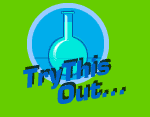
Explore The Nearshore
...sunlight only shines down 20 to 30 feet. In clearer water, the photic zone may be 60 feet deep. The Puget Sound is a great place to explore the nearshore environment. With nearly 2,500 miles of shoreline in the Northwest corner of Washington State, it's the second largest estuary in the United States. An estuary is a place where freshwater from rivers mixes with saltwater from the ocean, in an area sheltered from the rough surf of the ocean. The shoreline of the Puget Sound has many features: cliffs, rocky and sandy beaches, mudflats, wetlands, and marshes. Along the shoreline, you may see people kayaking, scuba diving, harvesting oysters, swimming, and strolling along the beach. You'll need a microscope to see some of the nearshore plants, but little fish have no trouble gobbling tiny treats called phytoplankton. Algae is probably one type of phytoplankton that you have seen, usually lying on the beach after high tide. Kelp, a slimy plant, is a type of brown algae that loves to grow in the nearshore environment. Images: Previous page: An illustration of the nearshore environment. Photo: King County. Top: The Puget Sound shoreline near Tacoma. Photo: Marita Graube
The Nearshore Grocery Store
Let's think of all the wildlife that "shop” for food at the nearshore. Many critters are considered prey, or a food source, for bigger animals, called predators, who eat the prey. Starting at the top of the food chain with the predators, there are many birds and mammals. A Bald Eagle likes to grab fish with its sharp talons and is even known to prey on smaller birds. Orca whales venture in deeper waters, but they also like to munch on fish from the nearshore. Fish such as salmon and trout are a favorite snack for many predators, like the Great Blue Heron and sea lion. But adult salmon are also predators themselves. They prey on insects and smaller fish, such as anchovies and herring. Insects love chewing the dead parts of plants, composting the nutrients into soil. Living in that soil are a number of worms, snails, clams, and fly larvae. Birds with long beaks are great at digging out those bug and worms for a meal. Crabs use their claws to break open a snail snack. Fish also love to splash up to eat those flies and bugs near the edge of the water. The nearshore is quite a busy "store!” Images: Top: A bald eagle rests near Mt. Rainier. Photo: King County Middle: An orca whale, one of many found in Puget Sound. Photo: King County 
Seaweed of the SoundEelgrass is an important nearshore plant. It wiggles like the long, slender creature called the eel, but this grass can grow up to 10 feet in length and creates a beautiful underwater forest. Eelgrass is a good food source, but it’s also a great place for small fish to hide from their predators. For this reason, the nearshore is considered a nursery environment, a place for young fish to grow up before leaving to swim in bigger areas of water.
Image: A shiner perch swims among the nearshore eelgrass. Photo: NOAA Photo Library | |

|







